Waves 2
1/35
Earn XP
Description and Tags
Name | Mastery | Learn | Test | Matching | Spaced |
|---|
No study sessions yet.
36 Terms
Superposition of waves
Overlap of two waves at a point in space
Principle of superposition (of waves)
When two waves meet at a point the resultant displacement at that point is equal to the sum of the displacements of the individual waves.
Interference
Superposition of two progressive waves from coherent sources to produce a resultant wave with a displacement equal to the sum of the individual displacements from the two waves
Constructive interference
Superposition of two waves in phase so that the resultant wave has greater amplitude than the original waves
Destructive interference
Superposition of two waves in antiphase so that the waves cancel each other out and the resultant wave has smaller amplitude than the original waves
Coherent waves/ waves sources
Waves/ waves sources that have a constant phase difference. For this to happen they must have the same frequency
Path difference
The difference in the distance travelled by two waves from their source to a specific point
Difference is often measured in wavelengths
Monocromatic wave source
A wave source that emits waves of a single frequency
How you can obtain two coherent light sources from a laser
Light from a Laser is coherent
The two slits act as two coherent point sources. They diffract the coherent light from the laser.
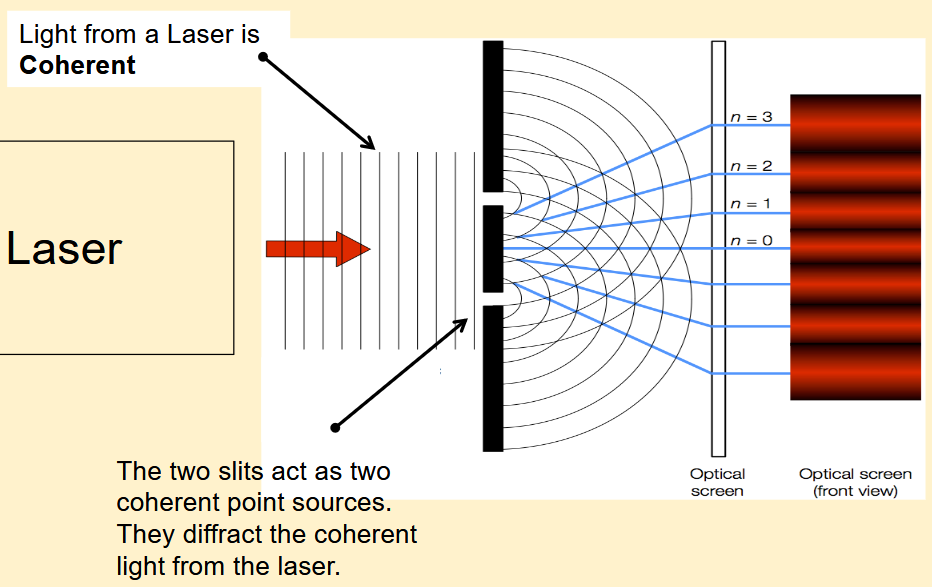
How you can obtain two coherent light sources from a white light filament bulb
Place a monochromatic filter in fron of the bulb.
The Monochromatic filter only transmits one wavelength.
A single narrow slit selects and diffracts the light from one point, so that all the light emerging from it is coherent.
The double slits act as two identical coheren point sources. They diffract the coherent light passing through them.
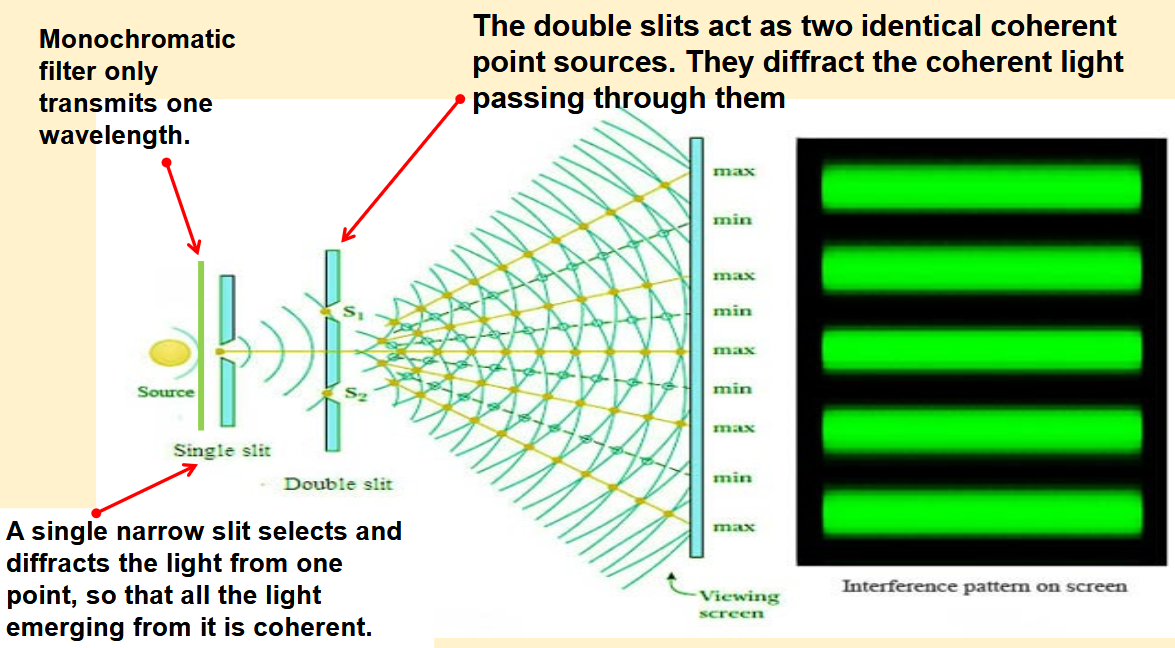
Young’s double slit equation
λ = ax/D
λ is the wavelength in metres, a is the slit separation in metres, x the fringe separation in metres, D is the distance between the slits and the screen in metres.
Youngs double slit experiment (diagram, equipment, method, analysis, uncertainties)
Aim of this experiment is to find the wavelength of a light source. λ is the wavelength, a is the slit separation, x the fringe separation, D is the distance between the slits and the screen.
Diagram:
Shown above
Equipment:
Laser
Double slit
White Screen
Ruler
Tape measure
Travelling microscope
Method:
To obtain two coherent sources shine light from a laser through a double slit.
The equipment needs to be set up so that D is greater than 1m. Measure the distance D with a tape measure.
Measure slit separation using a travelling microscope.
To find fringe spacing x, use the ruler to measure the distance from the centre of the first dot to the centre of the last visible dot. Count the number of spaces between the dots. x = distance / number of spaces
The distance is measured over a number of fringes to reduce the percentage uncertainty in x.
Increase D and repeat measurements to determine the new value of x . Repeat for this at least 6 different D values
Analysis:
Rearranging λ = ax/D gives x = λD / a
Plot a graph of x against D: x = (λ/a)D + 0
This should be a straight line through the origin
The gradient is equal to λ/a. Rearranging gives λ = gradient × a
Uncertainties:
The measurements of D, a and x all have uncertainties from the measuring instruments used. The absolute uncertainty in each remains constant, but the percentage uncertainty can be reduced. To do this, you can:
Increase D
For x, use x = distance / number of spaces, and measure the distance over a number of fringes
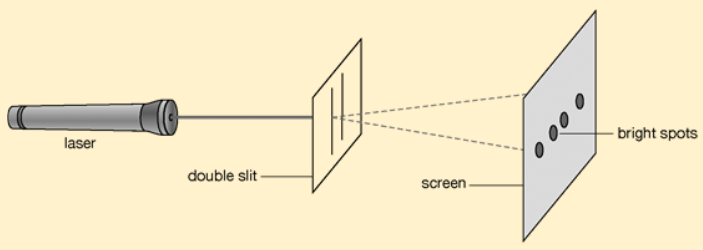
Monochromatic light
Light of a single frequency
Conditions necessary for the formation of a stationary wave
There must be two waves that superpose, and have:
The same wavelength or frequency
Equal and opposite velocities
Same or similar amplitudes
Key condition for harmonics to occur on string
The length of a vibrating section of string is a whole number of half wavelengths
This means the time for a wave to travel along the string & back is equal to the time for a whole number of waves

The diagram shows a string stretched between two posts. The string is plucked and a stationary wave is set up. What is the phase difference between P and Q?
A: 0 rad
B: π/4 rad
C: π/2 rad
D: π rad
A - 0 rad

Explain how the stationary wave is formed on the stretched string shown in the diagram
The oscillator creates a progressive wave that travels along the string. It is reflected at the pulley end.
The wave reflected at the pulley end superposes with the incident wave
This produces nodes and antinodes on the string.

Explain how a stationary sound wave is formed.
The louspeaker creates a progressive sound wave that travels along the tube. It is reflected at the end of the pipe
The wave reflected at the end of the pipe superposes with the incident wave.
This produces a resultant wave with nodes and antinodes.
Describe the difference between a stationary wave and a progressive wave
A stationary wave does not transfer energy, whereas a progressive wave does
A progressive wave transfers information / shape from one place to another whereas a stationary wave has nodes and antinodes (wave’s shape does not move along)
Conditions required for a stationary wave to form in a tube open at both ends
Both ends must be antinodes
The pipe must be nλ/2 in length for this to happen.
Stationary/ standing wave
Wave that remains in a constant position with no net transfer of energy
Characterised by its nodes and antinodes
Node
Point(s) on a stationary wave where the amplitude is always zero
Anti-node
Point(s) on a stationary wave where there is alway the maximum amplitude
2nd Harmonic in a string (diagram)

3rd Harmonic in a string (diagram)

2nd Harmonic in a air colomn closed at one end (diagram)
There is no 2nd harmonic, or any even harmonic, in an air column closed at one end
3nd Harmonic in a air colomn closed at one end (diagram)
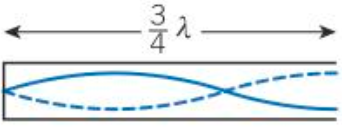
5nd Harmonic in a air colomn closed at one end (diagram)
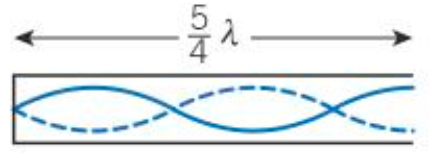
Fundamental frequency
The lowest frequency at which an object (e.g., an air column in a pipe or a string fixed at both ends) can vibrate
Fundamental mode of vibration
A vibration at the fundamental frequency; the first harmonic
Which type of ends do nodes form at on strings?
Nodes form at fixed ends of a string
Which type of ends do nodes form at in air columns?
Nodes form at closed ends of an air column
Phase difference of points between a pair of nodes
All points between the pair of nodes are in phase; they have 0 phase difference
Phase difference of points either side of a node
The points are in anti phase; phase difference = 180° / πc
Phase difference
How far ‘out of step’ the oscillations at two points on the same wave or similar waves are
Difference is normally measured in degrees/radians, but sometimes in fractions of a cylce or wavelength
Monochromatic filter
A filter that transmitts a single frequency of electromagnetic radiation